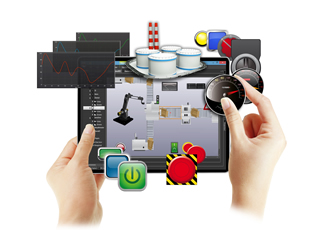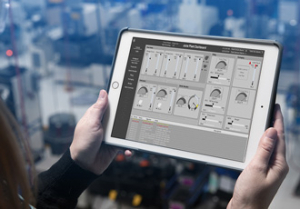Keeping users interested with easily adaptable SCADA graphics

Being easy to drag and drop in the design process in one quality that makes pre-set graphics attractive, especially ones that are easy to link to standard inputs, but it all contributes to make great looking SCADA screens. But they also need to be easily adaptable to custom requirements to keep users engaged. Paul Hurst of Products4Automation examines key trends in SCADA screen designs.
The last few years have seen radical changes in expectation for device interaction in the industrial world. This has largely been driven by comparison to graphical interfaces in consumer devices like tablets and smartphones that most engineers now use on a daily basis. The result is that today’s SCADA users are increasingly demanding and expecting not only stunning graphics but also the touch screen functionality that makes consumer devices so user-friendly. These include features such as the gesture control and multi-touch options we use in our everyday personal lives.
This presents a number of challenges to the designers of industrial and other SCADA systems. Firstly and most obviously, the interface of choice has to be able to support both gesture control and high resolution vector graphics. But designers also need to be able to easily develop and adapt pre-defined graphics that will ensure ongoing user engagement with the software. This will make it easier for users to identify and interpret the process information being presented, and also enable simple intuitive processes adjustments if required.
Most modern SCADA development suites will present the system designer with libraries of standard presets and graphics, many of which will be highly attractive. Coupled with this, the ability for drag and drop configuration and simple linking to standard inputs makes it easy to develop great looking and easy to read process screens that can quickly convey large amounts of information.
However, there is a very important question to consider: ‘Will they be scalable up and down for different screen sizes?’ Further we also have to ask: ‘How representative will the preset graphics be for each user’s individual process, as poor representation will reduce the ‘instant recognition’ of what is on a screen significantly?’
With its next generation Movicon NExT SCADA platform, Progea has addressed these various requirements for modern graphics. The platform is available in the UK from Products4Automation.
The graphics within the platform are based on WPF (Windows Presentation Foundation) and XAML (Extensible Application Markup Language). WPF uses a vector graphics rendering engine that is independent from the resolution and so takes full advantage of the modern graphics and Direct X hardware components. It offers a complete set of development features, including XAML, control data association, layout, 2D and 3D graphics, animation, styles, models, documents, multimedia elements text and typography. As such it is fully capable of enabling straightforward rapid and efficient development of SCADA screens.
The technologies provided within the NExT platform enable automation software developers to embrace the radical changes in device interaction that are taking place within the industrial world. This is allowing them to meet current and emerging operator expectations for interface system functionality.
To help even further, Movicon NExT SCADA has a huge suite of pre-set modules for equipment and a vast library of on-screen icons already programmed to represent both analogue and digital outputs of all types, from simple sensors to high level controllers.
Importantly, the Movicon.NExT graphics editor is completely integrated into the platform. This enables developers to use and easily adapt standard presets and graphics quickly without having to use external tools and without the need to build up XAML knowledge and experience. Developers only need to insert drawings, objects or symbols, configure their dynamic properties and associate them with tags from the data server.
When necessary, new symbols can be created by using the power templates and assigning styles, or by importing designs from other XAML-based graphics editors. This allows bespoke screens to be developed that truly represent the process under control in a clear and intuitively understandable way.
As screen requirements continue to evolve in the industrial environment in the coming years, user expectations for graphics quality and ease of interaction will continue to grow. The simplicity of adaptation of graphics and presets provided by Movicon.NExT will help to keep users engaged with their software platform. This will ensure that it continues to meet their informational needs throughout the lifetime of their individual process and futureproof financial and developmental investment.
Similar articles
More from Products4Automation
- Will 5G be a game changer for SCADA? 18th December 2019
- Controlling a textiles factory from home 22nd November 2019
- Increase production flexibility with better batch management 8th October 2019
- Cruise passengers stay cool with HVAC control systems 28th August 2019




 technology at Jacobs Vehicle Systems.JPG)







Write a comment
No comments